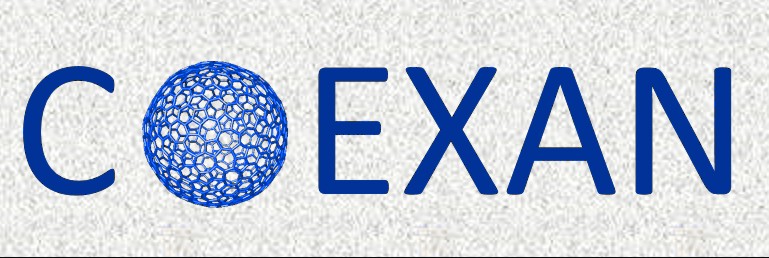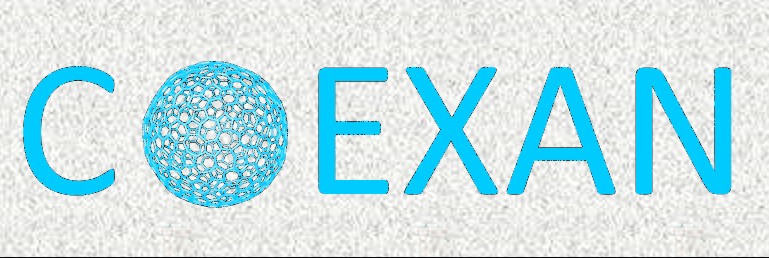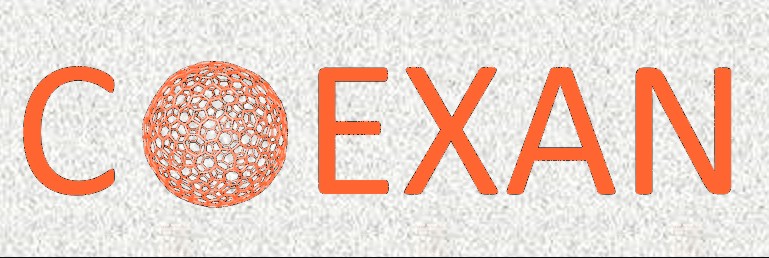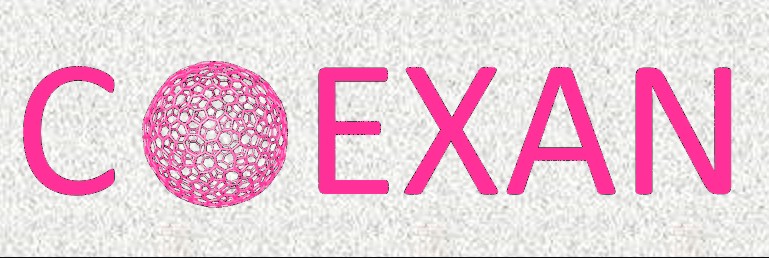
Title Collective Excitations in Advanced Nanostructures
Acronym CoExAN
Project ID 644076 Call H2020-MSCA-RISE-2014 Programme H2020
Duration in months: 48
Starting date: 1st October 2015
Key words:
carbon nanotube, graphene, graphene nanoribbons, biographene, lasing, generation, terahertz, exciton, phonon, polariton, Cerenkov radiation, nano-circuits, electro-magnetic nano-emittersAbstract
This project aims to develop, fabricate, theoretically and experimentally study carbon based nano-circuits which are able to generate, detect and process broadband electromagnetic (EM) signals. The carbon nanoscale EM sources can be based, in particular, on Cherenkov radiation emerging when electrons move inside carbon nanotubes (CNTs) or between spatially separated graphene sheets. The frequency of the Cherenkov radiation depends on the CNT radius and chirality or on the distance between graphene sheets. The performance of carbon EM nano-emitters is determined by the electron momentum relaxation time, which can be determined by measuring the generated THz and microwave fields. The frequency of the emitted EM radiation can be tuned by acoustic waves that provide distributed feedback for the EM wave. As well, the effects originating from strong coupling between material excitations in carbon-based structures and confined optical modes of microcavities will be investigated. The formation of polariton modes and their collective properties will be analyzed theoretically. Another set of problems to be considered in the proposed research is associated with the quantum mechanics and quantum optics of carbon-based nanostructures. We will look at excitonic and plasmonic collective effects in CNTs (especially narrow-band quasi-metallic ones, where excitonic effects are largely overlooked) and in few-layer planar Weyl materials such as graphene, silicene and germanene. We will also study collective photonics phenomena stemming from the quantum nature of light and look at sophisticated arrangements of carbon-based and other nanostructures in arrays or placing them in microcavities, thus utilizing the significant expertise of some of the participating groups in quantum optics aiming eventually at a design and feasibility study of novel advance-nanostructure-based optoelectronic devices including microwave, terahertz and light generators, detectors and frequency modulators.
Beneficiaries
1. Coordinator: University of Rome Tor Vergata (URTV), Italy. Official web-page: web.uniroma2.itPrincipal investigator: Prof. Olivia Pulci
2. University of Exeter (UNEXE), UK. Official web-page:
www.exeter.ac.uk
Principal investigator: Prof. Mikhail Portnoi
3. University of Eastern Finland (UEF), Finland.
Official web-page: www.uef.fi
Principal investigator: Prof. Yuri Svirko
4. University of Iceland (UI), Iceland. Official web-page:
english.hi.is
Principal investigator: Prof. Ivan Shelykh
5. The CNR Institute SPIN (SPIN) , Italy.
Official web-page: www.spin.cnr.it
Principal investigators: Prof. Alexey Kavokin and Prof. Andrey Varlamov
Partner Organisations
1. Research Institute for Nuclear Problems of Belarusian State University (INP BSU),Belarus. Official web-page: inp.bsu.byPrincipal investigators: Prof. Konstantin Batrakov, Dr. Polina Kuzhir
2. Yerevan State University (YSU), Armenia. Official web-page:
ysu.am
Principal investigator: Prof. Gagik Yurii Kryuchkyan
3. De La Salle University (DLSU), Philippines. Official web-page:
www.dlsu.edu.ph
Principal investigator: Prof. Richard Hartmann
4. V.Lashkaryov Institute of Semiconductor Physics,
National Academy of Sciences of Ukraine (ISP), Ukraine. Official
web-page:www.isp.kiev.ua
Principal investigator: Dr. Ihor Kupchak

WP1. Ab initio and Tight Binding calculations of electronic states in graphene ribbons, graphene/polymer sandwiches and CNT arrays
WP2. Theoretical study of collective phenomena associated with EM generation in graphene and other advanced carbon nanostructures
WP3. Fabrication and characterization of monolayered and multilayered graphene, graphene/polymer sandwich structures, graphene ribbons, CNT and CNT arrays
WP4. Experimental verification of the effects predicted within wp2
WP5. Management and coordination of the project. Training and Dissemination activities

The expertise of the participating teams covers different areas of contemporary physics and chemistry.
The URTV team will contribute to the first principles calculations, based on DFT and Many-Body
approaches and also provides synthesis of CNTs and CNT arrays. The UEF team is internationally recognized in the
field of graphene and graphene-like structures synthesis and characterization. It will supply single-, bilayer- and multi-layer
graphene, graphene nanoribbons and graphene/PMMA sandwiches that will be studied in this project. Researchers belonging
to the INP BSU team are experienced in the field of nanocarbon characterization, THz,
microwave and radio frequency measurements and data processing, numerical simulations and theoretical electromagnetics.
The INP BSU team possesses a wide range of material characterization facilities including Raman spectroscopy,
SEM, dc conductivity, microwave and THz measurements, optics, etc. The UNEXE and DLSU have complimentary high level
expertise in the study of collective phenomena in carbon nanotube arrays, graphene, topological insulators, and generally
in theoretical and mathematical physics including quantum and statistical mechanics of low-dimensional systems.
The activity of the UI team is mainly focused on theoretical mesoscopic optics and quantum transport. In the field of mesoscopic optics,
which is of particular importance for this project, the group is actively working on the theory of FIR-absorbtion in nano-scale systems,
photonic crystals, dynamics of exciton-polaritons in semiconductor microcavities and quantum optics of carbon based nanostructures.
The YSU team is well known in the field of application of solid-state systems and quantum optics to create innovative solutions to the
problem of collective excitations in advanced nanostructures. In particular, very recently the main attention of the team was in
laser accelerators, laser-induced multiphoton manipulation of atoms and molecules and nonlinear nano-electromagnetism.
The ISP team is an expert on electron-phonon interaction within ab-initio methods, and will give support to all the computational
work through optimization, writing and parallelization of codes

